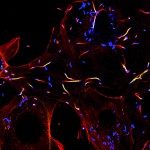Lien vers Pubmed [PMID] – 15456754
J. Biol. Chem. 2004 Dec;279(50):51931-8
FcgammaRIIB are low-affinity receptors for IgG that contain an immunoreceptor tyrosine-based inhibition motif (ITIM) and inhibit immunoreceptor tyrosine-based activation motif (ITAM)-dependent cell activation. When coaggregated with ITAM-bearing receptors, FcgammaRIIB become tyrosyl-phosphorylated and recruit the Src homology 2 (SH2) domain-containing inositol 5′-phosphatases SHIP1 and SHIP2, which mediate inhibition. The FcgammaRIIB ITIM was proposed to be necessary and sufficient for recruiting SHIP1/2. We show here that a second tyrosine-containing motif in the intracytoplasmic domain of FcgammaRIIB is required for SHIP1/2 to be coprecipitated with the receptor. This motif functions as a docking site for the SH2 domain-containing adapters Grb2 and Grap. These adapters interact via their C-terminal SH3 domain with SHIP1/2 to form a stable receptor-phosphatase-adapter trimolecular complex. Both Grb2 and Grap are required for an optimal coprecipitation of SHIP with FcgammaRIIB, but one adapter is sufficient for the phosphatase to coprecipitate in a detectable manner with the receptors. In addition to facilitating the recruitment of SHIPs, the second tyrosine-based motif may confer upon FcgammaRIIB the properties of scaffold proteins capable of altering the composition and stability of the signaling complexes generated following receptor engagement.
